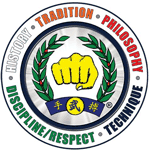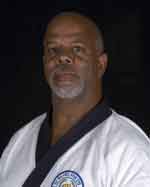 What characteristics exemplify a Moo Duk Kwan® “quality practitioner”?
What characteristics exemplify a Moo Duk Kwan® “quality practitioner”?
Certainly, producing practitioners with technical excellence is a proud distinction of the Moo Duk Kwan® and some may think of “quality” only in terms of technical performance, but there are so many other dimensions to becoming and being a Soo Bahk Do® practitioner, that viewing quality through only the narrow lens of technique is like trying to see all of our art through the peephole of a door.
The Kwan Jang Nim refers to “quality of practitioners” in his Vision Objectives as being one of the two most important outcomes of the Federation's activity. He goes on the define a quality practitioner as one who embodies and exemplifies our Moo Do values in their daily lives outside the dojang.

2009 Board Chairman, Charles Smith, Sa Bom Nim once requested a group of people to provide him with a one-word description of how they perceived him.
His question prompted me to think about the NPVT work that supports and quantifies some attributes of Quality Practitioners as they correlate to the contextual meaning expressed in the President's Vision Objectives and the Five Moo Do Values.
What are characteristics (or qualities) that you associate with a quality student practitioner, instructor, leader and/or Federation official?
The following thoughts are what I have come up with so far. I invite you to contemplate how you would express what “makes” a Moo Duk Kwan® quality Soo Bahk Do® practitioner and distinguishes them from other practitioners.
Seven Characteristics of a Moo Duk Kwan® Quality Soo Bahk Do® Practitioner
- Strives to achieve the technical expectations of proficiency expressed by the Kwan Jang Nim and TAC for practitioners
- takes pride in achieving Gup Rank Testing expectations
- takes pride in achieving Dan Rank Testing expectations
- takes pride in achieving Ko Dan Ja Rank Testing expectations
- takes pride in meeting and fulfilling Instructor Certification expectations
- takes pride in meeting and fulfilling Studio Certification expectations
.
- Demonstrates and supports a high moral and ethical standard of personal conduct that is appropriate and proper for a martial artist
- conscientiously adheres to the Federation's membership code of conduct
- abides by the Federations Joint Board and TAC Administrative Policies
- respects and abides by the Federation's Policy of non-discrimination and harassment at all times
- understands and abides by the terms of the Certified Instructor Letter of Understanding
- avoids unethical conduct at all times
- avoids conflicts of interest
- avoids creating or allowing any circumstances that could jeopardize one's credibility or integrity as a martial artist representing the Moo Duk Kwan® or the Soo Bahk Do® martial art system.
.
- Embraces and supports the spirit of the Founder's Mission 2000 Objectives
- seeks understanding and takes personal actions intent upon improve human relationships
- has a keen understanding of the concept and precepts of Moo
- demonstrates embodiment of Moo in one's daily life, ergo Moo Do
.
- Diligently displays key attributes of a martial artist as expressed by the Founder
- 8 Key Concepts
- courageous – possesses and exhibits the Yong Gi ~ brave energy necessary to speak up and/or standup for themselves, for others and for justice even in the face of adversity.
- 10 Articles of Faith on Mental Training
- self motivated – needs no external urging to take individual action
- composed – demonstrates Pyong Ahn ~ peaceful confidence and calm resoluteness, especially when confronted by adversity
- intent – demonstrates contemplation and thoughtfulness prior to speaking or taking action
- focused – demonstrates keen concentration ~ Chung Shin Tong Il before and while taking action
- * please post a COMMENT to add your characteristics or qualities to this incomplete list *
.
- Contemplates and embraces the essence of the Five Moo Do Values
- strives to exemplify the proper behavior of a true martial artist at all times
- conscientiously adheres to the Federation's membership code of conduct
- respects and abides by the Federation's Policy of non-discrimination and harassment at all times
.
- Comprehends and appreciates the intent of the President's Vision Objectives
- initiates personal actions that demonstrate Vision Participation
- initiates Random Acts of Moo Do
- actively embodies and applies mission objectives and vision objectives in one's daily life interactions with others
- engages in active advocacy of the Moo Duk Kwan® and the Soo Bahk Do® martial art system.
- seizes every opportunity to promote the public visibility of the Moo Duk Kwan® and the Soo Bahk Do® martial art system.
- Supports the Federation's initiatives to assure the long-term preservation of the Moo Duk Kwan® and the Soo Bahk Do® martial art system
- appreciates and embraces the Concept of Unity, community and purpose
- believes in acting for the common good of the community
- has read and understands the Federation's 501c4 Charter & Bylaws
- supports the Federation's 501c4 Chartered Purposes
- understands, appreciates and respects the Intellectual property shared by the Hwang family
- engages in active advocacy of the Moo Duk Kwan® and the Soo Bahk Do® martial art system
Think about the characteristics you observe in others, that you admire, aspire to, are inspired by, that motivate, etc. and help the NPVT in their work by contributing your perspective to this list of Seven Characteristics of a Moo Duk Kwan® Quality Soo Bahk Do® Practitioner.
You can post a comment on the page by using the COMMENT button at the bottom of the page and you can also help a friend add their thoughts by emailing them a link to this page or sharing the page on Facebook, etc.


